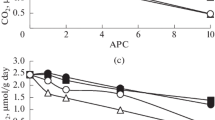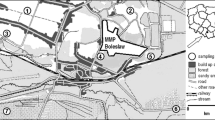Abstract
Concentrations of heavy metals (HM) that may have a significant negative impact on plants and soil microbiota have been identified at different pollution levels for sod-podzolic, gray forest, leached chernozem and chestnut soils. The investigated soils can be arranged in descending resistance to HM in the following order: leached chernozem, gray forest soil, chestnut, sod-podzolic soil. A comparison of the results of phytotoxicity determination in growing plants on soils and on soil extracts showed that phytotoxicity on soils polluted with HM appears at lower concentrations than on soil extracts. This is a consequence of low solubility of heavy metal compounds that are strongly sorbed by the mineral and organic components of soils, and also remain in the form of poorly soluble compounds.
Similar content being viewed by others
References
Agrokhimicheskie metody issledovaniya pochv (Agrochemical Methods for Soils Research), Sokolov, A.V., Ed., Moscow, 1975.
Anan’eva, N.D., Sus’yan, E.A., Ryzhova, I.M., et al., Microbial biomass carbon and the microbial carbon dioxide production by soddy-podzolic soils in postagrogenic biogeocenoses and in native spruce forests of the southern taiga (Kostroma oblast), Eurasian Soil Sci., 2009, vol. 42, no. 9, pp. 1029–1038.
Bezel’, V.S., Zhuikova, T.V., Gordeeva, V.A., et al., Aboveground phytomass and rate of plant debris decomposition in Herbaceous communities exposed to soil pollution with heavy metals, Russ. J. Ecol., 2016, vol. 47, no. 4, pp. 343–349.
Bulgakov, N.G., The way to indicate natural ecosystems state and to normalize the environmental factors. Methodological review, Usp. Soverm. Biol., 2002, vol. 122, no. 2.
Vedrova, E.F., Shugalei, L.S., and Stakanov, V.D., Carbon balance in natural and disturbed forests of south taiga of Northern Siberia, Geogr. Prir. Resur., 2002, no. 4.
Vinogradov, A.P., Geokhimiya redkikh i rasseyannykh elementov v pochvakh (Geochemistry of Rare and Scattered Elements in Soils), Moscow, 1957.
Vorobeichik, E.L., Sadykov, O.F., and Farafontov, M.G., Ekologicheskoe normirovanie tekhnogennykh zagryaznenii (Ecological Normalizing of Anthropogenic Pollutions), Yekaterinburg, 1994.
Vorob’eva, L.A., Teoriya i metody khimicheskogo analiza pochv (Soils Chemical Analysis: Theory and Methods), Moscow, 1995.
GN 2.1.7.204206. Gigienicheskie normativy. Orientirovochno dopustimye kontsentratsii (ODK) khimicheskikh veshchestv v pochve (GN 2.1.7.204206: Hygienic Standards. Approximate Permissible Concentration of Chemical Substances in Soil), Moscow
Glazovskaya, M.A., Metodologicheskie osnovy otsenki ekologo-geokhimicheskoi ustoichivosti pochv k tekhnogennym vozdeistviyam: Metodicheskoe posobie (Methodological Grounding for Estimating Soils Ecological-Geochemical Stability against Anthropogenic Impacts. Handbook), Moscow, 1997.
GOST R ISO (ISO Russian State Standard) 22030-2009: Soil Quality. Biological Methods. Chronic Phytotoxicity of Higher Plants, Moscow, 2011.
Zavarzin, G.A. and Kudeyarov, V.N., Soil as the key source of carbonic acid and reservoir of organic carbon on the territory of Russia, Herald Russ. Acad. Sci., 2006, vol. 76, no. 1, pp. 12–26.
Ivashchenko, K.V., Anan’eva, N.D., Vasenev, V.I., et al., Biomass and respiration activity of soil microorganisms in anthropogenically transformed ecosystems (Moscow Region), Eurasian Soil Sci., 2014, vol. 47, no. 9, pp. 892–904.
Il’in, V.B., Soil buffer properties and permissible level of its pollution by heavy metals, Agrokhimiya, 1997, no. 11.
Il’in, V.B. and Syso, A.I., Mikroelementy i tyazhelye metally v pochvakh i rasteniyakh (Microelements and Heavy Metals in Soils and Plants), Novosibirsk, 2001.
Kabata-Pendias, A. and Pendias, H., Trace Elements in Soils and Plants, Boca Raton: CRC Press, 2010.
Kaznina, N.M. and Titov, A.F., The influence of cadmium on physiological processes and productivity of Poaceae plants, Biol. Bull. Rev., 2014, vol. 4, no. 4, pp. 335–348
Kudeyarov, V.N. and Kurganova, I.N., Respiration of Russian soils: database analysis, long-term monitoring, and general estimates, Eurasian Soil Sci., 2005, vol. 38, no. 9, pp. 983–993.
Levin, S.V., Guzev, V.S., Aseeva, I.V., and Bab’eva, I.P., Heavy metals as an anthropogenic impact factor onto soil microbiota, in Mikroorganizmy i okhrana pochv (Microorganisms and Nature Preservation), Moscow, 1989.
Plekhanova, I.O. and Kutukova, Yu.D., How to prepare waste water deposits and soils fertilized by sludges for analysis under heavy metals content monitoring, Agrokhimiya, 2004, no. 12.
Polyanskaya, L.M. and Zvyagintsev, D.G., The content and composition of microbial biomass as an index of the ecological status of soil, Eurasian Soil Sci., 2005, vol. 38, no. 6, pp. 625–634.
SanPiN 2.1.7.573-96. 2.1.7. Pochva. Ochistka naselennykh mest. Bytovye i promyshlennye otkhody. Sanitarnaya okhrana pochvy. Prilozhenie 10. Metodika biotestirovaniya po prorashchivaniyu semyan (SanPiN 2.1.7.573-96. 2.1.7. Soil. Cleaning of Residential Areas. Household and Industrial Wastes. Sanitary Protection of Soil, Appendix 10: Biotesting Method for Seed Germination), Moscow: Minzdrav Rossii, 1997
Smorkalov, I.A. and Vorobeichik, E.L., Soil respiration of forest ecosystems in gradients of environmental pollution by emissions from copper smelters, Russ. J. Ecol., 2011, vol. 42, no. 6, pp. 464–471.
Sokolova, T.A., Specificity of soil properties in the rhizosphere: analysis of literature data, Eurasian Soil Sci., 2015, vol. 48, no. 9, pp. 968–981.
Stepanov, A.L. and Lysak, L.V., Metody gazovoi khromatografii v pochvennoi mikrobiologii: Uch.-metod. pos. (Gas Chromatography for Soil Microbiology. Student’s Book), Moscow, 2002.
Telesnina, V.M., Vaganov, I.E., Klimovich, E.Yu., and Chalaya, T.A., The distinctive features of biological turnover in postagrogenic ecosystems of the south taiga and their effects on the chemical properties and biological activities of soils, Moscow Univ. Soil Sci. Bull., 2013, vol. 68, no. 2, p. 90.
Timofeev, M.A., Terekhova, V.A., and Kozhevin, P.A., Biotesting for Cd pollution in soils, Moscow Univ. Soil Sci. Bull., 2010, vol. 65, no. 4, pp. 179–183.
Trifonova, T.A., Sakhno, O.N., Zabelina, O.N., and Feoktistova, I.D., Comparative assessment of the state of urban soils based on their biological activity, Moscow Univ. Soil Sci. Bull., 2014, vol. 69, no. 3, pp. 112–116.
Yakovlev, A.S., Kaniskin, M.A., and Terekhova, V.A., Ecological evaluation of artificial soils treated with phosphogypsum, Eurasian Soil Sci., 2013, vol. 46, no. 6, pp. 697–704.
Coleman, D.C., From peds to paradoxes: linkages between soil biota and their influences on ecological processes, Soil Biol. Biochem., 2008, vol. 40, pp. 271–289.
Hargreaves, P.R., Brookes, P.S., Ross, G.J.S., and Poulton, P.R., Evaluating soil microbial biomass carbon as an indicator of long-term environmental change, Soil Biol. Biochem., 2003, vol. 35, no. 3, pp. 401–407.
Gesch, R.W., Reicosky, D.C., Gilbert, R.A., and Moms, D.R., Influence of tillage and plant residue management on respiration of a Florida everglades histosol, Soil Tillage Res., 2007, vol. 92, pp. 156–166.
Meychik, N.R. and Yermakov, I.P., Ion-exchange properties of plant root cell walls, Plant Soil, 2001, vol. 234, no. 2, pp. 181–193.
Schlesinger, W.H. and Andrews, J.A., Soil respiration and global carbon cycle, Biogeochemistry, 2000, vol. 48, no. 1, pp. 7–20.
Wang, M., Markert, B., Shen, W., et al., Microbiol biomass carbon and enzyme activities of urban soils in Beijing, Environ. Sci. Pollut. Res., 2011, vol. 18, no. 6.
Author information
Authors and Affiliations
Corresponding author
Additional information
Original Russian Text © I.O. Plekhanova, O.A. Zolotareva, I.D. Tarasenko, 2018, published in Vestnik Moskovskogo Universiteta, Seriya 17: Pochvovedenie, 2018, No. 4, pp. 36–46.
About this article
Cite this article
Plekhanova, I.O., Zolotareva, O.A. & Tarasenko, I.D. Application of Biotesting Methods at Assessment of Ecological State of Soils. Moscow Univ. Soil Sci. Bull. 73, 164–174 (2018). https://doi.org/10.3103/S014768741804004X
Received:
Published:
Issue Date:
DOI: https://doi.org/10.3103/S014768741804004X




